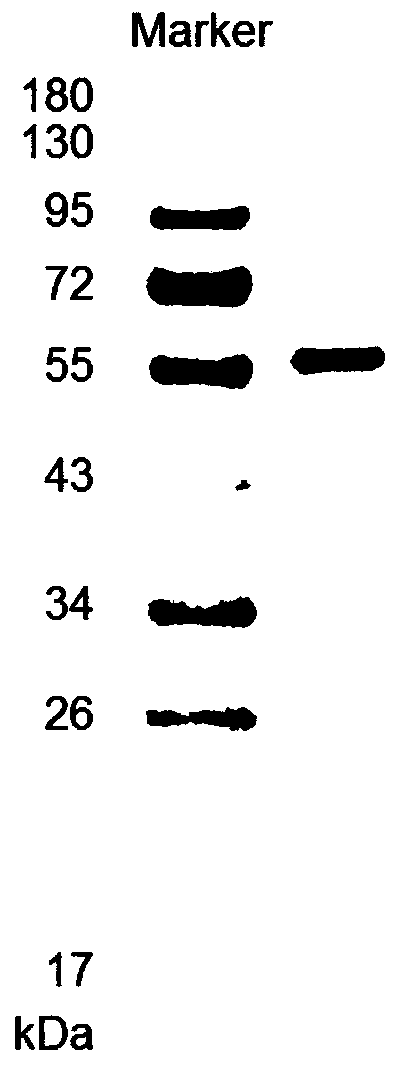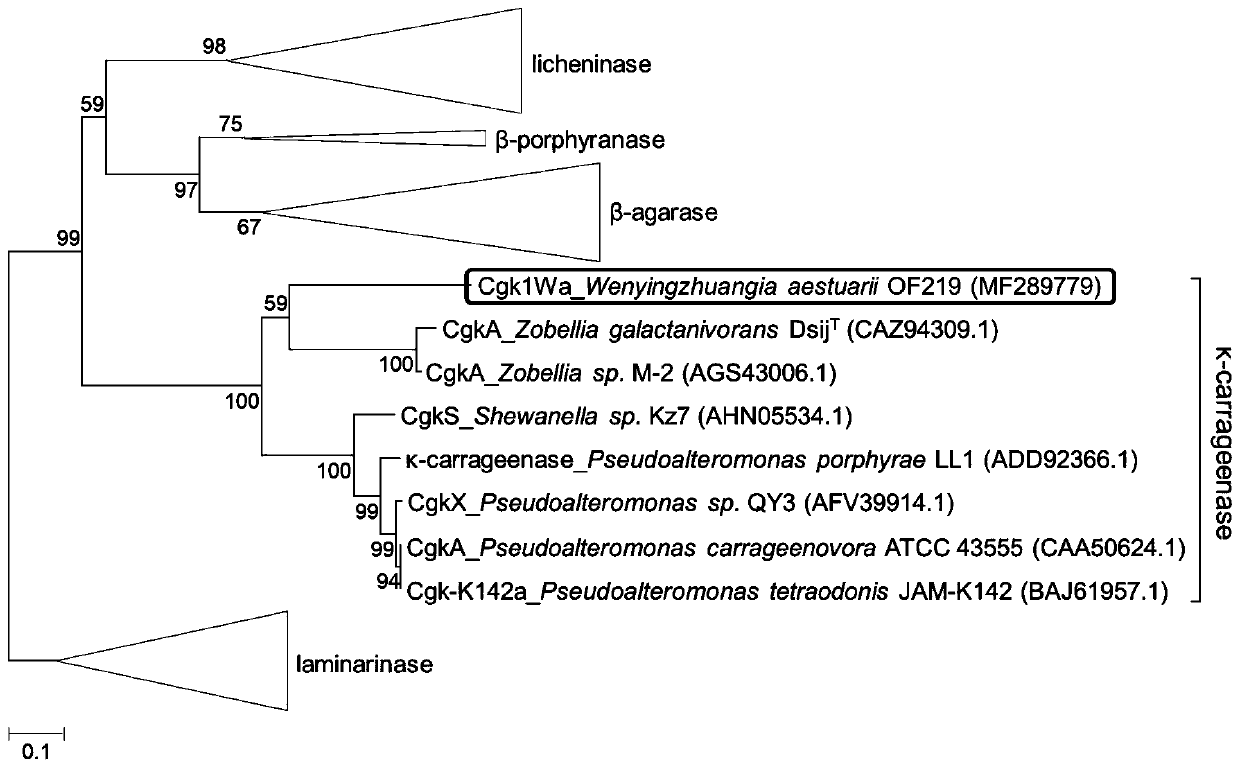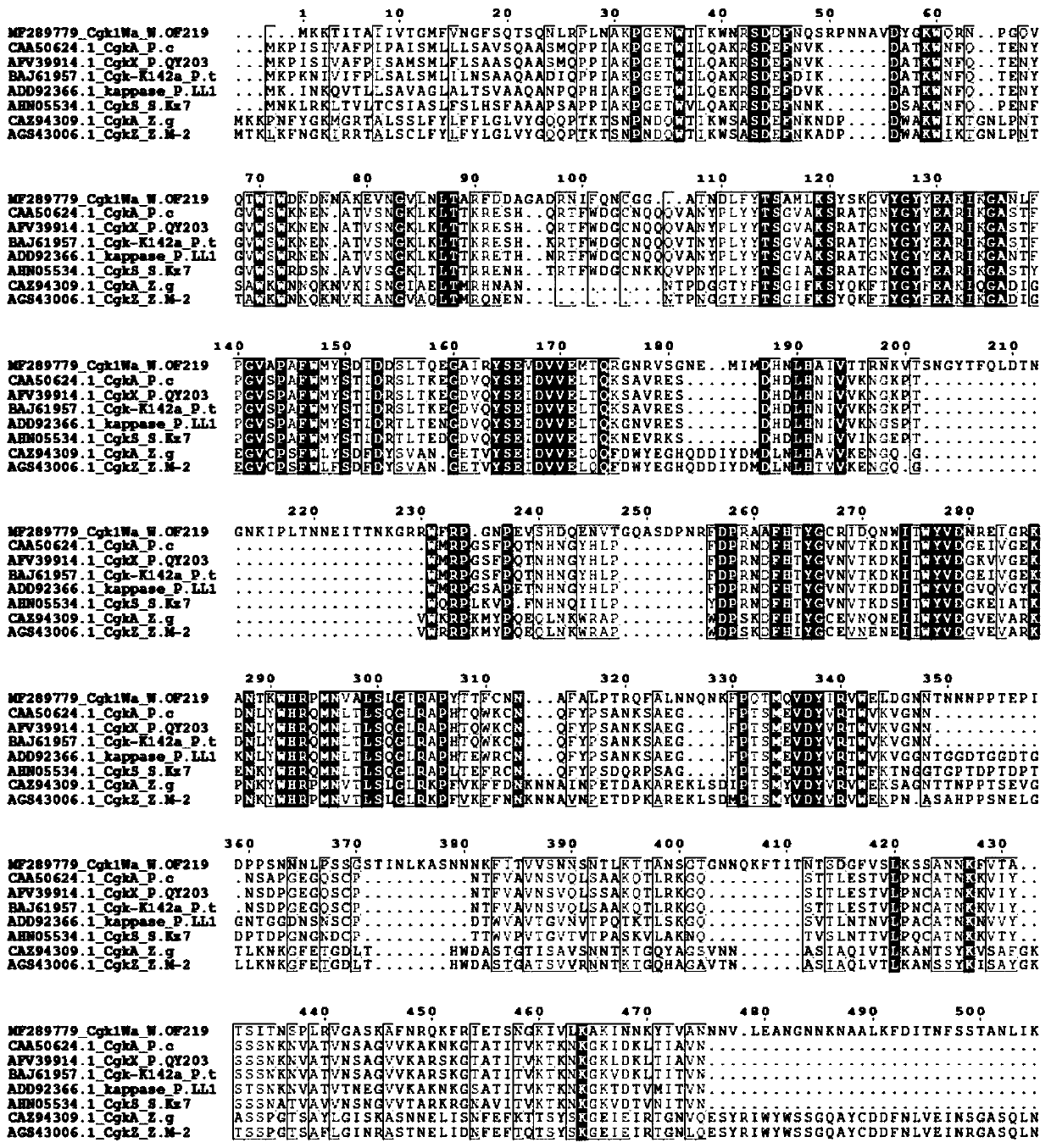Method for quantitatively detecting kappa-carrageenan by enzymic method
A quantitative detection and carrageenan technology, applied in the field of biotechnology and biochemical detection, can solve the problems of time-consuming, laborious, poor reproducibility, and complicated operation.
- Summary
- Abstract
- Description
- Claims
- Application Information
AI Technical Summary
Problems solved by technology
Method used
Image
Examples
Embodiment 1
[0033] Example 1: Cloning, expression and acquisition of κ-carrageenase Cgk1_Wa in Escherichia coli
[0034] Wenyingzhuangia aestuarii OF219 was cultured in 2216E medium until the end of the logarithm and the whole genome DNA was extracted. The upstream and downstream primers (5'- GACACGGATCCACTTCTCAAAATTTAAGACCGCTTAATGC; 5'- GACACCTCGAGTTAATCTATAATTATTTTTTGGGTTTTAATTCC) were designed according to the target gene, and PCR was carried out using the whole genome as a template. The PCR reaction conditions were: : 95°C for 3 minutes, 94°C for 30s, 58°C for 30s, 72°C for 150s, 22 cycles, and finally 72°C for 5 minutes to obtain the κ-carrageenase Cgk1_Wa gene fragment, which was connected to the DH5α vector to form a recombinant plasmid. The recombinant plasmids were introduced into BL21(DE3) competent cells to form recombinant strains. The expression was induced by isopropylthiogalactoside in LB medium containing kanamycin, the induction temperature was 17°C, and the induction tim...
Embodiment 2
[0036] Example 2: Cloning, expression and acquisition of κ-carrageenase Cgk1_Wa in Bacillus subtilis
[0037]Wenyingzhuangia aestuarii OF219 was cultured in 2216E medium until the end of the logarithm and the whole genome DNA was extracted. The upstream and downstream primers (5'-GTACACGGATCCACTTCTCAAAATTTAAGACCGCTT; 5'-TTAGCTCGAGTTAATCTATAATTATTTTTTGGGTTTACCG) were designed according to the target gene, and the whole genome was used as a template for PCR as in Example 1. The κ-carrageenase Cgk1_Wa gene fragment was obtained and connected to the pHT01 vector to form a recombinant plasmid. The recombinant plasmid was transformed into competent cells of Bacillus subtilis, positive clones were screened and expressed in LB culture medium with isopropylthiogalactoside, the induction temperature was 38°C, and the induction time was 14h. Collect the cells by centrifugation, add a certain amount of 20mM Na 2 HPO 4 -NaH 2 PO 4 Suspend in the buffer, and then perform ultrasonic crus...
Embodiment 3
[0038] Example 3: Cloning, expression and acquisition of κ-carrageenase Cgk1_Wa in Pichia pastoris
[0039] Wenyingzhuangia aestuarii OF219 was cultured in 2216E medium until the end of the logarithm, and the whole genome DNA was extracted, and the upstream and downstream primers (5'- GGAATGGATCCACTTCTCCAAAATTTAAGACCGCTTAA; 5'-CCGTATCGAGTTAATCTATAATTATTTTTTGGGTTTTAGGCC) were designed according to the target gene, and the whole genome was used as a template for PCR as in Example 1. The κ-carrageenase Cgk1_Wa gene fragment was obtained, connected to the pPIC9k vector to form a recombinant plasmid, and added to Pichia pastoris GS115 competent cells to form a recombinant cell; positive clones were screened and inoculated in YPD medium, cultured at 30°C for 20 hours, and then Inoculate in BMGY medium, culture on a shaker at 30°C and 200rpm until OD600=2.0, collect the bacteria by centrifugation, discard the supernatant, resuspend the pellet in BMMY medium, induce culture with methan...
PUM
 Login to View More
Login to View More Abstract
Description
Claims
Application Information
 Login to View More
Login to View More - R&D
- Intellectual Property
- Life Sciences
- Materials
- Tech Scout
- Unparalleled Data Quality
- Higher Quality Content
- 60% Fewer Hallucinations
Browse by: Latest US Patents, China's latest patents, Technical Efficacy Thesaurus, Application Domain, Technology Topic, Popular Technical Reports.
© 2025 PatSnap. All rights reserved.Legal|Privacy policy|Modern Slavery Act Transparency Statement|Sitemap|About US| Contact US: help@patsnap.com



